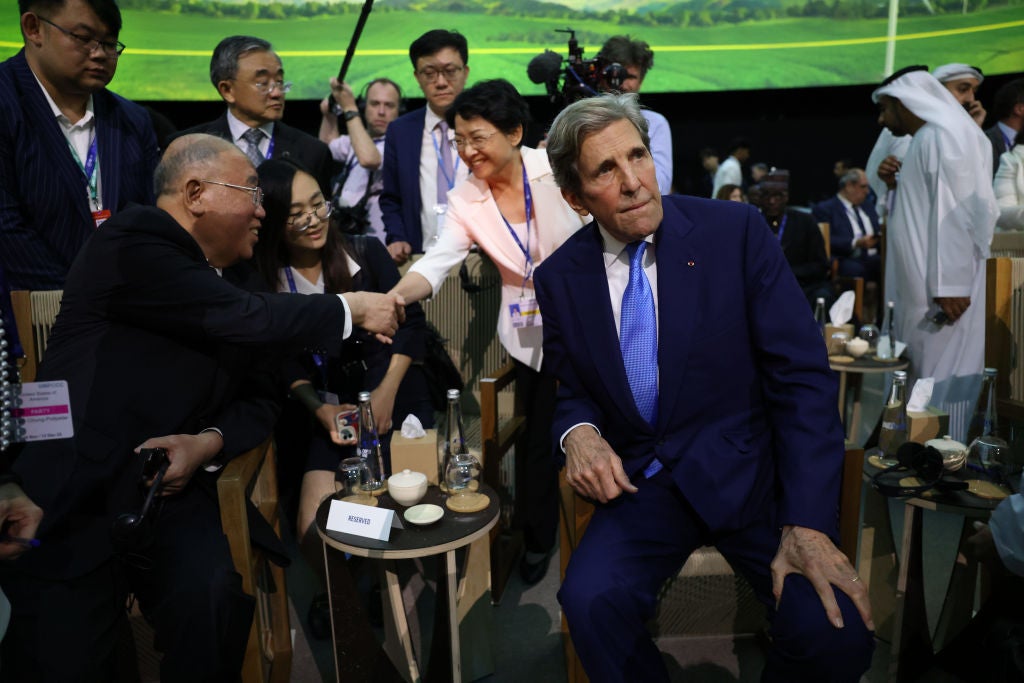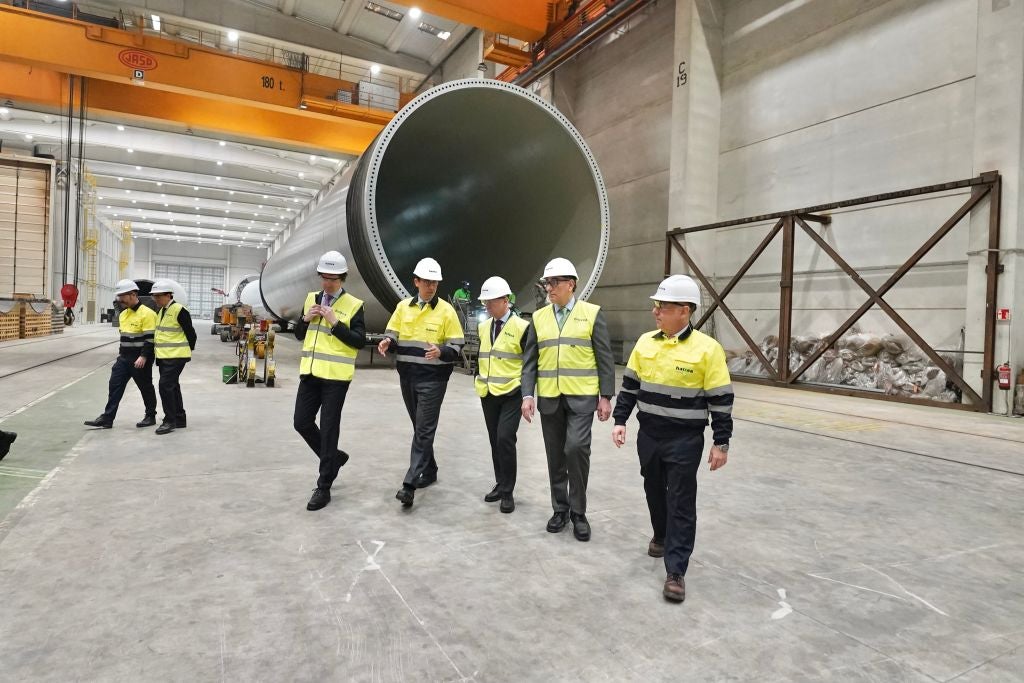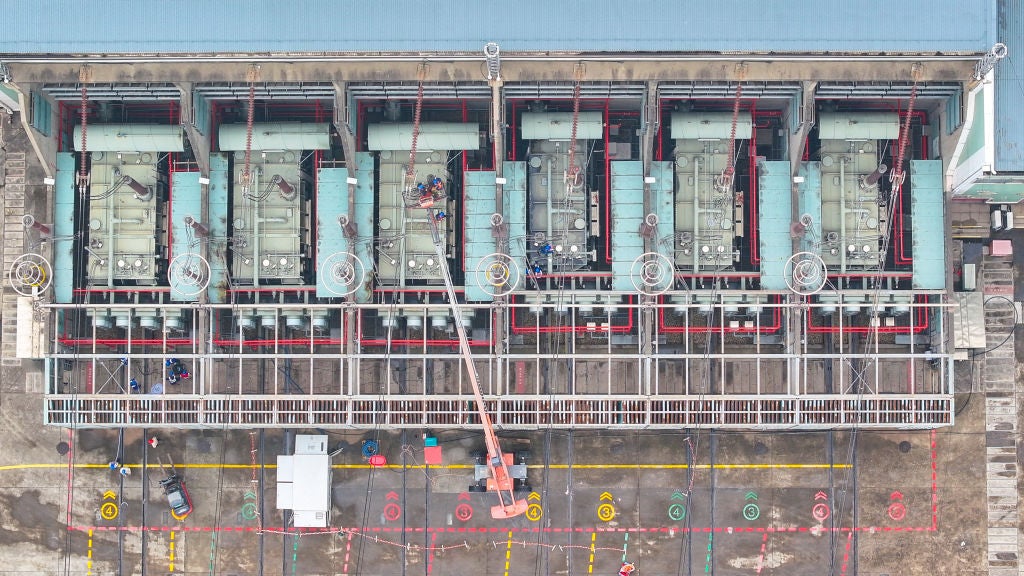
DUBAI – Despite having worked on the global pledge for tripling renewables capacity for an entire year, alongside the COP28 presidency and the European Commission, Ben Backwell, CEO at the Global Wind Energy Council, is “pleasantly surprised by how well it has gone” and by “how many countries adopted [the pledge]” at COP28 in Dubai.
Speaking to Energy Monitor, Backwell, who is also vice-chair of the new Global Renewables Alliance, explains that the pledge, now signed by 119 countries, “is a really significant step” because it is the first time renewables ambitions are “aligned with the Paris agreement“.
Under the pledge, countries have committed to working together towards tripling the world’s installed renewable energy generation capacity to at least 11TW by 2030, as well as collectively doubling the global average annual rate of energy efficiency improvements from 2% to more than 4% every year until 2030. Although it is widely expected that the tripling renewables pledge will make it into the main text of the final COP28 declaration, there are two notable absences from the list of signatories: China and India.
China’s absence, after first endorsing the pledge as part of the G20 in September, is all the more notable given that just weeks earlier it pledged its support for this goal as part of a US-China bilateral climate deal signed at Sunnylands, California.
As part of the Sunnylands deal, China agreed to “support the G20 Leaders Declaration to pursue efforts to triple renewable energy capacity globally by 2030”, as well as to “sufficiently accelerate renewable energy deployment in their respective economies through 2030 from 2020 levels so as to accelerate the substitution for coal, oil and gas generation”.
See Also:
“It is disappointing that China has not yet shown climate leadership [by signing on to the global pledge],” Camilla Fenning, programme lead at think tank E3G, told Energy Monitor in Dubai. China is already a world leader in clean energy with an impressive renewables rollout, she pointed out. With a combined onshore and offshore wind capacity of more than 310GW, China’s total wind capacity is roughly equal to that of the other top seven countries globally, according to June 2023 analysis by the non-profit Global Energy Monitor.
How well do you really know your competitors?
Access the most comprehensive Company Profiles on the market, powered by GlobalData. Save hours of research. Gain competitive edge.

Thank you!
Your download email will arrive shortly
Not ready to buy yet? Download a free sample
We are confident about the unique quality of our Company Profiles. However, we want you to make the most beneficial decision for your business, so we offer a free sample that you can download by submitting the below form
By GlobalDataFenning suggests an explanation for China’s absence: “We understand that China may have been reluctant to sign the pledge because it flagged the need to end investment in new unabated coal power plants and perhaps because it is hesitant about its domestic energy efficiency progress.”
In addition to its wording on renewables and energy efficiency, the text of the global pledge asks that signatories “recogniz[e] that, according to the IEA [International Energy Agency] and IPCC [Intergovernmental Panel on Climate Change], in order to meet the Paris Agreement goal, renewables deployment must be accompanied in this decade by a rapid increase of energy efficiency improvements and the phase down of unabated coal power, in particular ending the continued investment in unabated new coal-fired power plants, which is incompatible with efforts to limit warming to 1.5°C”.
Just this week, the US, along with a handful of other countries, joined the Powering Past Coal Alliance, which commits members to phasing out all use of unabated coal power.
Xinyi Shen, a researcher at the non-profit Centre for Research on Energy and Clean Air, agrees that the pledge’s reference to coal is likely a factor in China not signing the pledge.
“[Despite the Sunnylands statement] indicat[ing] China’s strong support for tripling global renewables, which would significantly benefit its cleantech manufacturing industry, […] the difference in opinion of this COP28 pledge for China might be related to coal,” they told Energy Monitor.
They added: “Despite China’s world leading progress in developing clean energy, its expansion of coal power has been a setback.”
Barbara Monterrubio, an energy analyst at GlobalData, Energy Monitor’s parent company, suggests that despite China currently accounting for 50% of global renewable capacity – with this expected to increase to 53% by 2030 – the country’s “focus to ensure energy security to cover their energy demand, as a country with a fast-increasing population and high industrial activity, has probably prevented them from going ahead with this pledge”.
Keep up with Energy Monitor: Subscribe to our weekly newsletterChina’s failure to sign the pledge could also reflect the country’s take on the credibility of the COP28 negotiations, says one China expert at a global think tank, speaking to Energy Monitor on the condition of anonymity.
“[It is] clear that if any country should sign up to this declaration it should be China [given the scale of its renewables rollout],” he says. “[But] China has a deep resistance in general to any declarations, initiatives and statements that are made in parallel with COP28.” It sees them as a “PR stunt”, he says.
In addition, “if [China] signs something internationally, they have to make sure they can deliver on the promise”, he adds; China’s “uncertainty” that it can meet the tripling renewables pledge “also explains their reservation”, he suggests.
Based on existing policies, China is currently on track to double its renewables capacity by 2030, according to recent analysis from the think tank Ember. However, the think tank argues that as China’s clean energy deployment “continues to exceed expectations” – the country hit its 2025 target of renewables exceeding 50% of total installed electricity generation capacity in June 2023 – it has the ability to deliver “substantially more” than existing forecasts.
Backwell says that although the global supply chain is currently "insufficient" to deliver the tripling target, China, which controls 65% of the global renewables supply chain – as well as 55% of the market – is probably investing "at the right rate for its own market and to have some capacity to export".
"Everyone else has been underinvesting," Backwell adds.
It remains to be seen whether or not China will support the target when (and if) it makes it into the final COP28 text. It is worth noting, says the China expert speaking to Energy Monitor on condition of anonymity, that there is a "subtle difference" between China "actively signing the declaration", which it sees as binding, and "not opposing this target".
Read more from this author: Polly BindmanIndia's refusal to sign the pledge was also a surprise, given the country supported the tripling pledge at the G20 summit, held in Delhi, earlier this autumn.
Madhura Joshi, a senior associate on India at E3G, says: "[It is] disheartening that India has not signed on to the global pledge... These were landmark decisions that were championed by the Indian G20 presidency and agreed to by G20 leaders in September 2023."
Nevertheless, Joshi says: "[The] good news is that India already has ambitious targets on renewables – 450GW by 2030 – and a thriving energy efficiency programme spanning sectors.
"My hope is that India – a global renewables leader – will champion tripling renewables and doubling energy efficiency by 2030 at COP28 in the main text," he told Energy Monitor. "India is a global renewables leader and its support will provide a boost for the global renewables sector."







